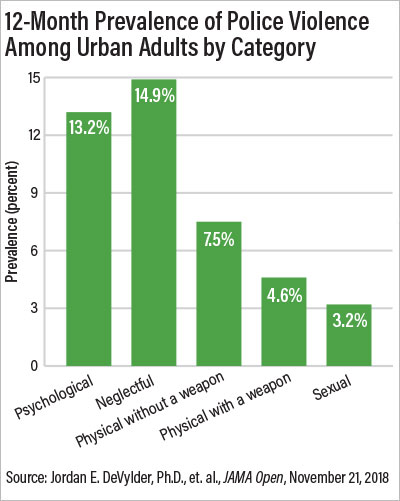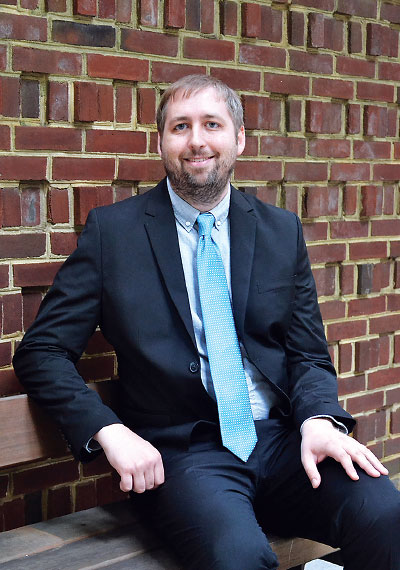Exposure to Police Violence Linked to Suicide Risk, Psychosis
Abstract
People of color and members of sexual minorities are more likely to experience police violence.
Experiencing police violence is associated with a higher risk for suicide attempts, suicidal thinking, and psychotic experiences, according to a study published in JAMA Network Open. The study, which was based on a cross-sectional, general population survey of 1,000 residents of Baltimore and New York City from October through December 2017, also suggests that people of color and sexual minorities are more likely to experience police violence.

In their research, Jordan E. DeVylder, Ph.D., an associate professor in the Graduate School of Social Services at Fordham University, and colleagues evaluated data from the Survey of Police-Public Encounters II. This survey asks about experiences with police violence over the past 12 months. The types of police violence included physical violence with a weapon, physical violence without a weapon, psychological violence (threats, intimidation, and more), sexual violence, and neglect (not responding to calls for assistance, responding too late, and more) (see chart). The survey respondents were also asked to report psychological distress (including feelings of hopelessness, agitation, and depression), suicidal thinking, suicide attempts, and psychotic experiences.
In addition, the researchers determined risk according to race/ethnicity, sexual orientation/identity, and age. Compared with non-Hispanic whites, people of color had more than a fourfold increased risk of experiencing police violence with a weapon and more than a threefold increased risk of experiencing the other forms of police violence. Those who identified as homosexual or bisexual had nearly a twofold increased risk of psychological violence. Most exposures occurred among people aged 44 years or younger.
DeVylder told Psychiatric News that some of the data surprised him.
“There is a narrative in the media that [police violence] affects a lot of urban communities, especially those of color, so we did expect the data to reflect that. [But] the prevalence of police violence was [still] higher than I expected it to be, especially among the subgroups,” DeVylder said. “One group that stood out that I want to research further is transgender people. They were a small subset of only six, but four of the six had some kind of victimization with a weapon by a police officer.”
Physical violence with a weapon and sexual violence were associated with the greatest increase in risk for suicide attempts, suicidal thinking, and psychotic experiences. Physical violence with a weapon was associated with more than a sevenfold increase for suicide attempts, nearly a threefold increase in risk for suicidal thinking, and more than a fourfold increase in risk for having psychotic experiences. Sexual violence was associated with more than a sixfold increase in risk for suicide attempts and psychotic experiences and nearly a fourfold increase in risk for suicidal thinking. Physical and sexual violence were associated with greater distress than the other forms of police violence.

Jordan DeVylder, Ph.D., noted that four of the six transgender people in the study had experienced police violence with a weapon, indicating a need for further study of police violence against them.
DeVylder noted that police neglect may also take a toll on mental health.
“If you’re living in a place perceived as unsafe, and [you feel that] when you call for help, it might not come, it’s distressing,” DeVylder said. In their paper, DeVylder and his colleagues called attention to the broad effects of police violence in the United States.
“Police violence constitutes a public health problem that is important to address because of the expanse of its potential mental health consequences and the limited attention it has received from policymakers and researchers. [Our] findings suggest the need for clinicians to be attuned to the prevalence of police violence among patient populations, especially racial/ethnic minorities, males, young adults, and economically disadvantaged individuals.”
DeVylder encouraged psychiatrists to consider whether their patients have been affected by police violence.
“Along with all the other social and environmental risks you think about, keep in mind that this could be happening to the people you work with and it’s affecting their mental health. It’s a problem that needs to be addressed in a way that’s sensitive to the difficult nature of these experiences,” DeVylder said.
This study was supported by the University of Maryland School of Social Work and Fordham University. ■
“Association of Exposure to Police Violence With Prevalence of Mental Health Symptoms Among Urban Residents in the United States” can be accessed here.



